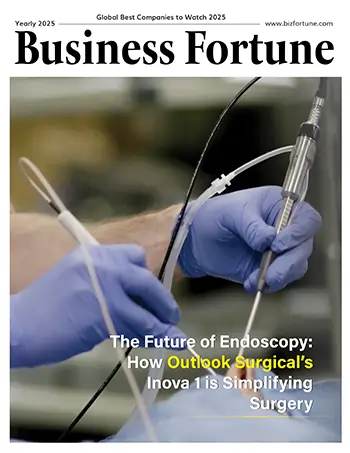Home Innovation Mobile Key Steps in the Mobile App De...
Key Steps in the Mobile App Development Lifecycle
Mobile

Business Fortune
18 September, 2024
The term "mobile app development lifecycle" refers to the steps involved in creating an app. Comprehending the app development process form a business perspective is crucial as it aids in creating a schedule and reducing expenses.
The timing and complexity of app development are influenced by a number of factors from the app's conception to deployment. Knowing every step of the mobile app design and development process will allow you to confidently direct and oversee the work of your IT staff.
Key Steps in the Mobile App Development Lifecycle
We are surrounded by a wealth of evidence indicating that mobile apps developments are there to stay and dominate. With over a million apps available on both the Apple and Google Play stores, an average user can easily spend over 35 hours per month using them, according to data. We could understand why these statistics are accurate if we only examined our personal phones and usage habits. Let's examine the steps involved in mobile app development lifecycle stages, what to anticipate, and how this article might assist you.
-
The Planning/Research Stage: The first thing you should do is start with a thorough analysis of your market and the apps that your competitors currently have.
-
Wireframes: Documenting and wireframing your application is the next stage. Creating thorough sketches of your ideal app—its features, appearance, and other details—will be very helpful when developing and implementing the app in the future.
-
Technical viability & Back-End Assessment: After you have a firm grasp on your design, you must determine whether the back-end systems are able to support the functionality of your application. Consider things like push alerts, servers, APIs, data integration, and data graphs.
-
Prototyping: At this point, you ought to quickly construct a prototype. An App testing method cannot be fully understood without using it and seeing how the workflows work.
-
Design: At this point, you ought to quickly construct a prototype. An app's experience cannot be fully understood without using it and seeing how the workflows work.
-
Develop: In a way, this stage begins very early. The development stage includes everything from creating a workable prototype to testing it at each level.
-
Testing: In the mobile app development lifecycle stages, testing is an essential phase. Early testing is usually a good idea because it may assist control the ultimate expenditures.
-
Deployment: At this stage, your application ought to be prepared for submission. Decide the day to hold the official launch.
Introduction to Mobile App Development
When we discuss smartphone applications, the first ones that spring to mind are the ones we use on a daily basis, such as Whatsapp, Instagram, Swiggy, etc. Have you ever wondered how these applications are created? Which technology is applied? Let's talk about the frameworks and technologies that can be used to create mobile applications.
Three operating systems are primarily used to develop mobile apps:
-
Android
-
iOS
-
Windows
There are three methods for creating mobile applications: -
-
Frist- party native app creation
-
A cutting-edge web application
-
Third- Platform Utilization
Understanding the Development Lifecycle
Development teams employ the software development lifecycle (SDLC) as a time- and money-efficient method for designing and creating high-quality software. By proactive planning, SDLC aims to reduce project risks and ensure that software satisfies customer expectations both during and after production.
Managing software development may prove difficult because of shifting needs, advancing technology, and interdisciplinary cooperation. At each level of the app development process, the software development lifecycle (SDLC) methodology offers a defined set of deliverables and a methodical management framework.
These are a few advantages of SDLC:
-
Better communication between all parties engaged in the app development process
-
More effective calculation, planning, and scheduling
-
Better cost estimation and risk management
-
More efficient software delivery and increased client contentment
Initial Planning and Research
Planning and research begin with a thorough examination of competitors, thorough market research, and user needs. It helps you find possibilities and market gaps, which lays the groundwork for your App testing methods. However, you can develop an outline for your project for an app through study.
- Design and Initiation
The User interface design (UI) and user experience (UX) are brought to life through design. Prioritizing visual attractiveness and user-friendliness is essential. Wireframing, building prototypes, and choosing design elements that complement the identity of your app are all part of the design step.
- Phase of Development
The "final" draft of the app's code is really written during the development stage. Here's where you utilize the wireframes' comments to help you make some last, maybe significant decisions. It's also crucial to incorporate a data engine into the application at this stage.
- Testing and Assurance of Quality –
The program must go through a number of inspection and testing procedures in order to find and fix any bugs or inconsistencies that might affect its functionality, security, usability, or general user experience.
An illustration of the value of quality assurance is the introduction of a well-known banking app.
- Starting and Using
Depending on what platform you developed your app for; you'll need to consider several distribution methods when the time comes to launch it.
The distribution method for mobile applications is quite straightforward to implement. You will have to choose between distributing your program privately and submitting it to Google Play Store or Apple program Store.
- Follow-Up Initiatives
Best wishes! Public access is now possible for your app. Your labor is not done, though. Once your app is out, you basically go back to the Mobile app design and prototyping phase. After considering user input and maybe implementing some App performance optimization new features, you'll re-release the product. These five processes will be repeated, gradually improving your product to meet the needs of your target market.
Defining Project Goals and Requirements
Without an understanding of business needs, goals, and regulations, an app idea is worthless. In order to comprehend how the enterprise fits with the concept from the first phase, you are encouraged to gather its needs in this step.
-
Determine who the key players are in developing the best software for mobile applications according to the business concept.
-
To comprehend the project's scope, clearly and concisely define the business goals and objectives.
-
Use elicitation approaches to obtain user and stakeholder requirements.
- User interface design & Experience
The user interface design (UID) is the visual style, presentation, and general interactive aspects of a product, whereas the user experience (UX) consists of a set of activities aimed at optimizing a mobile application for efficient and pleasurable use.
Users can complete functional tasks on many platforms and services with the aid of UX design.
- Selecting the Appropriate Technology Stack
Your budget and available resources, the kind of app you want to develop, the platform you are interested in working on (iOS, Android, or both), the functions and features you want to include, and other variables will all affect which tech stack is best for mobile app developmet.
- App Performance optimization and debugging
Thorough testing and effective debugging are necessary for an Android app to be of high quality. Error detection and correction during testing across multiple platforms can be time-consuming and varied.
Because every device has a different testing environment, testers need to employ multiple testing and launch strategies at different times.
- Mobile App Maintenance and Updating
Ensuring that your app is secure against the most recent security threats requires regular mobile app maintenance and upgrades. Assuring adherence to the most recent security standards and patching vulnerabilities are essential for protecting user data and gaining the audience's trust.
- Collecting User Input and Rework
To learn more about the needs of your users and pinpoint places where your user flows need to be improved, do interviews, polls, and usability tests.
Including User Input: Don't merely gather input—actually do something with it! Iterate through the user flows to make the experience more user-centered according to the insights you obtain.
Conclusion:
To sum up, a successful app requires an understanding of the mobile application development lifecycle. Every stage is important, from designing and planning to developing, evaluation, and launching. You may continuously enhance your app by paying attention to the needs and input of your users. The software must receive regular upgrades and maintenance in order to remain safe and user-friendly. You may create an app that satisfies user needs and achieves your goals with the correct strategy and a well-defined procedure.
FAQ:
1) What are the key phases in the mobile app design and development lifecycle stages?
- Major Stages of the Lifecycle of Developing a Mobile App:
-
Planning: Specify features and objectives.
-
Design: Produce user experiences and interfaces.
-
Development: Write the application's code.
-
Testing: Look for errors and problems.
-
Launch strategies: Make the app available to users.
-
Maintenance: After launch, update and correct problems.
2) How important is the design phase in mobile app development?
Significance of the Design Phase:
- The design phase holds great significance as it molds the way users engage with the application. Well-designed software is visually appealing and simple to use, which keeps users interested.
3) What are some common methods for testing mobile apps?
Typical App for testing methods:
-
Manual Testing: By using the program, users test it for bugs.
-
Automated Testing: To perform tests automatically, use software tools.
-
Beta Testing: Provide the software to a limited user base in order to gather feedback.
4) How can app developers optimize performance during development?
Improving Efficiency While in Development:
-
Code Optimization: To speed up the application's operation, write effective code.
-
Minimize Resource Consumption: Restrict battery and memory utilization.
-
Make use of caching: temporarily store data to expedite access.
5) What are the best practices for maintaining a mobile app post-launch?
Guidelines for Keeping a Mobile App Up to Date after Launch:
-
Frequent Updates: Include new features and address bugs.
-
Monitor Performance: Pay attention to how the application functions.
-
User feedback: Pay attention to what people have to say and adjust as necessary.
-
Stay Current: Stay informed on emerging technologies and app development trends.


































